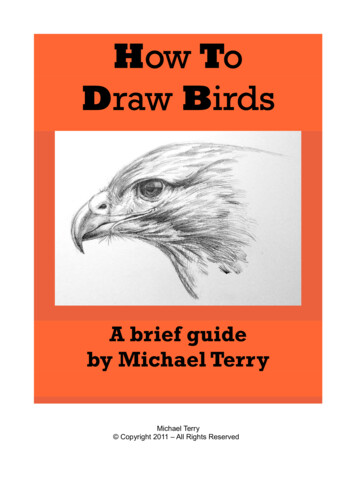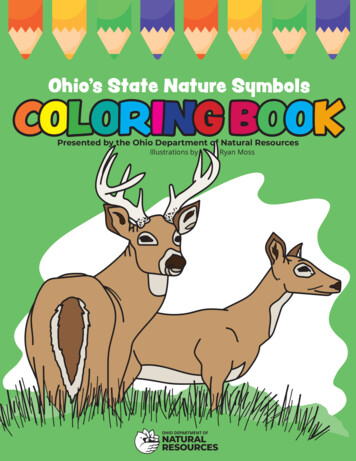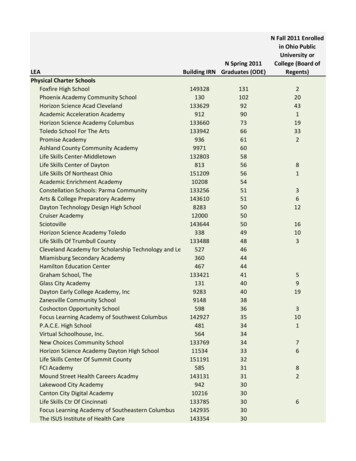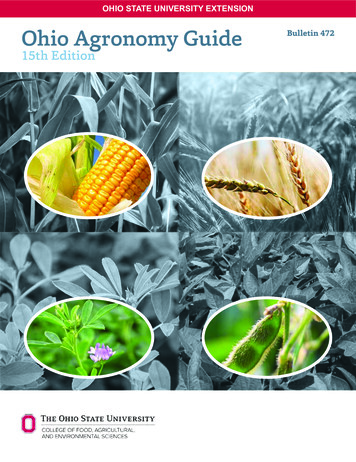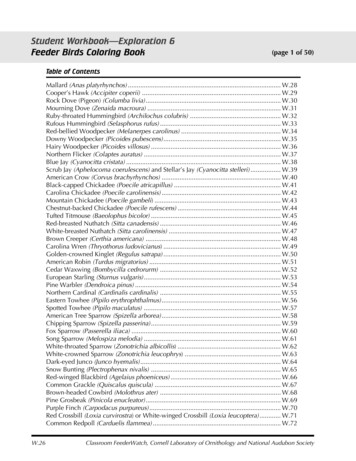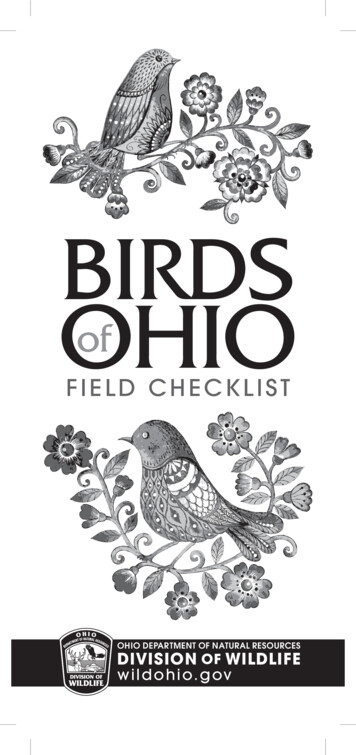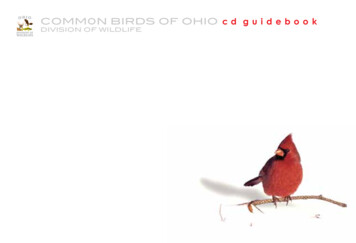
Transcription
COMM0N BIRDS OF OHIO c d g u i d e b o o kDIVISION OF WILDLIFE
Family NameS o n g sKnowing the sounds of our birds isimportant to becoming a better birder,as many birds are quite secretive andhard to see, but their calls are easilyheard. The birder with knowledge ofsongs and calls will find more birds, including many that would otherwise goundetected. In some cases the best wayto confirm identification is by the songor call. Finally, learning the sounds ofOhio’s songsters can greatly increaseone’s enjoyment of the natural world.This CD contains 103 of Ohio’s mostcommon breeding birds that are foundprimarily in upland habitats. Most ofthese sounds were recorded in Ohio,and each species includes songs andcalls that are most typically heard.Habitat can be a clue to a bird’s identity, and many birders also use mnemonics – memory devices – to helplearn and remember songs. Refer to thetext in the booklet that accompaniesthis CD for helpful information regarding habitats and tips that might aid inlearning these sounds.Common NameSpecies PhotoBarn Swallow Hirundo rusticaT R AC K # 3 7Like the purple martin, barn swallows arevery much associated with humans. Thisbird is aptly named; they typically build theirnests on support beams in barns, or underoverhangs of sheds and other buildings. Barnswallows are unmistakable, with their verylong forked tails and orangish underparts.They are quite vocal, emitting a continuousbarrage of rapid twittering notes.DescriptionPageQuick Info: Range, Habitat, and Best SpotsRANGE:Common statewide.HABITAT:Allen ClaybonB i r dOpen countryside,especially agricultural areas.BEST SPOTS:Easily found in suitable areas throughoutOhio; like other swallows, often queuesup in large flocks in late summer. photo by:B o r r o r / O D O WHOW TO USE THIS BOOKPhoto Credit27Black-capped Chickadee Poecile atricapillusT R AC K # 3 8 ATrack Numbercorresponses withaccompaying audio CDThis species is extremely similar to the Carolina chickadee, but is easily differentiatedwith practice by their vocalizations. Blackcappeds occur north of the Carolina’s range,and for the most part they don’t overlap.The song of the black-capped chickadee is atwo-parted whistled fee-bee, and their chik-adee-dee calls are much huskier and slower intempo than the Carolina chickadee.RANGE:David Van MeterCOMMON BIRDS of OhioRoughly the northern ¼ ofOhio, from Mansfield north.HABITAT:Similar to the Carolina chickadee.BEST SPOTS: photo by:IntroductionEasily found in appropriate habitat;Killdeer Plains WA is a noteworthy siteto observe chickadees, as both specieshave been reported there.Best Spots: AbbreviationsMP Metropark (county)NP National ParkNWR National Wildlife RefugeSF State ForestSNP State Nature PreserveSP State ParkTNC The Nature ConservancyWA Wildlife AreaCOMMON BIRDS of OHIOTABLE OF CONTENTS04 Birding Hot Spots06 Groups & Organizations08 Species Accounts60 Birding Fast Facts61 Contact Information62 Publication Funding
SPECIES ACCOUNTS8 Ring-necked Pheasant21 Eastern Phoebe34 American Robin47 Eastern Towhee8 Ruffed Grouse21 Great Crested Flycatcher34 Gray Catbird47 Chipping Sparrow9 Wild Turkey22 Eastern Kingbird35 Northern Mockingbird48 Field Sparrow9 Northern Bobwhite22 White-eyed Vireo35 Brown Thrasher48 Vesper Sparrow10 Red-tailed Hawk23 Yellow-throated Vireo36 Cedar Waxwing49 Savannah Sparrow10 American Kestrel23 Blue-headed Vireo36 Blue-winged Warbler49 Grasshopper Sparrow11 Killdeer24 Red-eyed Vireo37 Northern Parula50 Henslow’s Sparrow11 Mourning Dove24 Warbling Vireo37 Yellow Warbler50 Song Sparrow12 Black-billed Cuckoo25 Blue Jay38 Chestnut-sided Warbler51 Swamp Sparrow12 Yellow-billed Cuckoo25 American Crow38 Black-throated Green Warbler51 Dark-eyed Junco13 Eastern Screech-Owl26 Horned Lark39 Yellow-throated Warbler52 Northern Cardinal13 Great Horned Owl26 Purple Martin39 Pine Warbler52 Rose-breasted Grosbeak14 Barred Owl27 Barn Swallow40 Prairie Warbler53 Blue Grosbeak14 Common Nighthawk27 Carolina Chickadee40 Cerulean Warbler53 Indigo Bunting15 Whip-poor-will28 Black-capped Chickadee41 Black-and-white Warbler54 Dickcissel15 Chimney Swift28 Tufted Titmouse41 American Redstart54 Bobolink16 Ruby-throated Hummingbird29 White-breasted Nuthatch42 Prothonotary Warbler55 Red-winged Blackbird16 Red-headed Woodpecker29 Carolina Wren42 Worm-eating Warbler55 Eastern Meadowlark17 Red-bellied Woodpecker30 House Wren43 Ovenbird56 Common Grackle17 Downy Woodpecker30 Sedge Wren43 Louisiana Waterthrush56 Brown-headed Cowbird18 Hairy Woodpecker31 Marsh Wren44 Kentucky Warbler57 Orchard Oriole18 Northern Flicker31 Blue-gray Gnatcatcher44 Common Yellowthroat57 Baltimore Oriole19 Pileated Woodpecker32 Eastern Bluebird45 Hooded Warbler58 Purple Finch19 Eastern Wood-Pewee32 Veery45 Yellow-breasted Chat58 House Finch20 Acadian Flycatcher33 Hermit Thrush46 Summer Tanager59 American Goldfinch20 Willow Flycatcher33 Wood Thrush46 Scarlet TanagerON THE COVER: NORTHERN CARDINAL
OHIO BIRDING HOT SPOTS41 Lake La Su An WA2 Goll Woods SNP3 Maumee State Forest4 Oak Openings MP5 Maumee Bay SP6 Ottawa NWR7 Magee Marsh WA8 Resthaven Wildlife Area9 Mentor Headlands SNP10 Cuyahoga Valley NP11 Holden Arboretum12 Grand River WAUNGLACIATEDABBREVIATION KEYMP MetroparkNER National Esturarie ReserveNP National ParkNWR National Wildlife RefugeSF State ForestSNP State Nature PreserveSP State ParkTNC The Nature ConservancyWA Wildlife AreaGLACIATEDUnder each species account in this bookletis a section titled “Best Spots”. The generalstatewide location of these sites is shown onthe adjacent map. See page 6 for a listing ofcontact information for various agencies andorganizations to learn more.OHIO BIRDING TRAILSAppalachian Discoveryappalachiandiscovery.comHocking Valley Birding Traibirdhocking.comOhio Lake Erie Birding Traillakeerieohiobirding.infoMAP COURTESY: ODNR DIVISION OF GEOLOGICAL SURVEY
13 Quail Hollow State Park14 Tinkers’ Creek State Park15 Mohican State Forest16 Beaver Creek State Park17 Woodbury Wildlife Area18 Egypt Valley Wildlife Area19 The Wilds20 Tri-Valley Wildlife Area21 Hocking SF/SP(Conkle’s Hollow SNP)22 Clear Creek MP23 Waterloo Wildlife Area24 Tar Hollow State Forest25 Zaleski SF/Lake Hope SP26 Lake Katharine SNP27 Crown City Wildlife Area28 Shawnee State Forest29 Edge of Appalachia TNC30 Tranquility Wildlife Area31 Indian Creek Wildlife Area32 Miami-Whitewater MP33 Hueston Woods State Park34 Paint Creek Wildlife Area35 Spring Valley Wildlife Area36 Killdeer Plains Wildlife Area37 Findley State Park38 Funk Bottoms Wildlife Area39 Killbuck Wildlife Area40 Big Island Wildlife Area41 Alum Creek State Park42 Blendon Woods MP43 Hoover Reservoir44 Green Lawn Cemetery45 Deer Creek Wildlife Area46 Davey Woods SNP47 Lawrence Woods SNP48 Mercer Wildlife AreaOHIO LAKE ERIE BIRDING TRAILL A K E E R I E O H IO B I R D I N G . IN F O
One of the best ways to get involved withbirding is to join a group of like-mindedpeople. Fortunately, Ohio has a number ofactive groups throughout the state that havemany birders as members, and most of theseorganizations host field trips regularly. Listedbelow are the names and contact informationfor many of the state’s birding groups.6The Park Building 140 Public SquareCleveland, OH 44114UNGLACIATED1 AUDUBON SOCIETY OF GREATER CLEVELANDGLACIATEDBIRDING GROUPS AND ORGANIZATIONS 216-861-5093www.clevelandaudubon.org2 AUDUBON SOCIETY OF OHIO3398 West Galbraith Rd. Cincinnati, OH 45239 513-741-7926http://home.earthlink.net/ audsocohio/3 AUDUBON SOCIETY/MAHONING VALLEYP.O. Box 3214 Youngstown, OH 44512members.cboss.com/audubonmv/4 AUDUBON MIAMI VALLEYP.O. Box 556 Oxford, OH 45056www.orgs.muohio.edu/audubonmiamivalley/5 BLACKBROOK AUDUBON SOCIETY7573 Dahlia Drive Mentor, OH 44060 440-255-0961www.blackbrookaudubon.orgMAP COURTESY: ODNR DIVISION OF GEOLOGICAL SURVEY
6 BLACK RIVER AUDUBON SOCIETY304 West Ave Elyria, OH 44035www.blackriveraudubon.org7 BLACK SWAMP AUDUBON SOCIETYP.O. Box 7086 Defiance, OH 435128 BLACK SWAMP BIRD OBSERVATORYP.O. Box 228 Oak Harbor, OH 43449 419-898-4070www.bsbobird.org9 CANTON AUDUBON SOCIETYP.O. Box 9586 Canton, OH 44711 330-832-249110 CINCINNATI BIRD CLUBwww.cincinnatibirds.com/birdclub11 COLUMBUS AUDUBONP.O. Box 141350 Columbus, OH 43214 740-549-0333www.columbusaudubon.org12 DAYTON AUDUBON SOCIETY1375 East Siebenthaler Ave Dayton, OH 45414 937-293-4876www.dayton.net/Audubon/13 EAST CENTRAL AUDUBON SOCIETYP.O. Box 55 Granville, OH 4302314 FIRELANDS AUDUBON SOCIETYP.O. Box 967 Sandusky, OH 4487015 GREAT AKRON AUDUBON SOCIETYP.O. Box 80056 Akron, OH 44308 330-315-5213www.cs.uakron.edu/ pelz/gaas.html16 GREATER MOHICAN AUDUBON SOCIETYP.O. Box 907 Ashland, OH 44805http://audubon.cjb.net/17 KELLEYS ISLAND AUDUBON CLUBP.O. Box 42 Kelleys Island, OH 43438www.kelleysislandnature.com18 KIRTLAND BIRD CLUBwww.kirtlandbirdclub.org19 OHIO BIRD CONSERVATION INITIATIVEwww.obcinet.org/index.html20 OHIO BLUEBIRD SOCIETYPMB 111 343 West Milltown Rd.Wooster, OH 44691www.obsbluebirds.com21 OHIO ORNITHOLOGICAL SOCIETYP.O. Box 14051 Columbus, OH 43214www.ohiobirds.orgACKNOWLEDGEMENTThe Borror Laboratory of Bioacoustics (BLB) is a research and serviceunit of the Department of Evolution,Ecology and Organismal Biology atThe Ohio State University. It is locatedin the OSU Museum of Biological Diversity.The BLB houses one of the largestcollections of recorded animal soundsin the world. Founded by the late Dr.Donald Borror, Professor of Entomology and Zoology at The Ohio StateUniversity, the collection containsover 34,000 recordings of over 1500species of animals.22 PRESIDENT R. B. HAYES AUDUBON SOCIETYP.O. Box 92 Fremont, OH 4342023 SHAWNEE NATURE CLUB4362 Swauger Valley Rd Portsmouth, Ohio 45662 740-820-838224 TOLEDO NATURALISTS’ ASSOCIATIONwww.toledonaturalist.org25 TRI-MORAINE AUDUBON SOCIETYP.O. Box 5648 Lima, OH 4580226 WESTERN CUYAHOGA AUDUBON SOCIETY4310 Bush Avenue Cleveland, OH 44109 216-741-2352www.wcasohio.orgBORROR LABORATORY OF BIOACOUSTICSThe Ohio State University 1315 Kinnear RoadColumbus, OH 43212-1192 614-292-2176http://blb.biosci.ohio-state.edu/
Phasianus colchicusRANGE:Statewide, with locally abundantpopulations in northwest and central Ohio.Habitat:Open country with a mosaic ofgrasslands, overgrown fence rows,and rowcrop agricultureBest Spots:Deer Creek WA, Big Island WA,and Lake La Su An WA.Tim DanielTRACK # 2This spectacular Eurasian species was introduced into Ohio in 1896, and is very popularwith sportsmen. Look for them in open countryside that has a mosaic of brushy fields,open meadows, cornfields, and overgrownfence rows. The male makes a loud, unmistakable crowing unlikely to be confused withany other bird. photo by:Ring-necked Pheasant8Ruffed Grouse Bonasa umbellusRange:Southern and eastern Ohio, from AdamsCounty north to Ashtabula County.Habitat:Forests, particularly in young, scruffyclearcuts and brushy thickets.Best Spots:Most state forests, such as Shawnee,Tar Hollow, and Zaleski; Waterloo WA. photo by: Tim DanielTRACK # 3These partridge-like birds are forest inhabitants, often congregating where brush piles ordowned trees litter the understory. Grouseoccur in greatest numbers in young, regenerating forests; especially those less than twenty years old. The drumming of the males –which sounds a bit like an old lawn mowerbeing started – is made by the bird quicklyrotating its wings, creating a vacuum thatproduces a loud booming sound.
Wild Turkey Meleagris gallopavoRange:Throughout Ohio, but most common in theunglaciated areas of the south and east.Habitat:Best Spots:Throughout the Hocking Hills,The Wilds, and Lake Katharine SNP.9Tim DanielA wide variety of deciduous forest; turkeysoften forage in fields near woodland borders. photo by:TRACK # 4A true conservation success story, Wild turkeys had disappeared from Ohio by 1904. Reintroductions began in 1956, and today theyare again common throughout much of thestate. The “gobbling” of males is unmistakable, but birds also make a variety of clucksand other sounds. Watch for turkeys in fieldsalong woods, especially early in the morning.Northern Bobwhite Colinus virginianusRange:Distributed primarily in thesouthern fourth of Ohio.Habitat:Open country interspersed with brushythickets, scattered trees, grasslands,reverting fields, and pastures.Best Spots:Crown City, Tranquility and Woodburywildlife areas are excellent places tolook for Northern bobwhites. photo by: Tim DanielTRACK # 5Once a common bird throughout Ohio, bobwhites have declined significantly and aremostly found in limited areas in the southernfourth of the state. The male’s characteristicsong, a cheery, whistled Bob-white! – often delivered from high in a tree – is a perfect example of onomatopoeia, or a word that is closelyimitative of a sound.
Red-tailed Hawk Buteo jamaicensisHabitat:All types of open landscapes,woodlots, urban parks, and open forests.Best Spots:Easily found almost anywhere. Killdeer PlainsWA is particularly good, and large migrationscan occur along Lake Erie in March.American Kestrel Falco sparveriusTRACK # 7Formerly known as the “sparrow hawk,”the American kestrel is the smallest NorthAmerican falcon. They are very adaptableand occur throughout Ohio, and are oftenseen perched on roadside wires. Kestrels frequently “wind hover,” fluttering in one spothigh in the air when prey is sighted below.They also nest in cavities, and can be enticedto use appropriate nest boxes. Their call is aloud, penetrating killy killy killy.Range:Common throughout the state.Habitat:A wide variety of open landscapes,urban parks, meadows; often seen huntingalong the margins of roadways.Best Spots:Easily found throughout the state; theyare a sure thing along International Roadthrough The Wilds, where nest boxeshave been placed; Mercer WA photo by: Tim Daniel10Range:Common throughout the state. photo by: Tim DanielTRACK # 6This is probably the most common of Ohio’shawks, and certainly the most conspicuous. Red-tailed hawks are commonly seenperched along freeways and roads, wheretheir white underparts cause them to standout. Red-tails have adapted well to urbansituations, and are often seen in cities andtowns. Their typical call is a loud descending scream, which is sometimes mimicked byblue jays.
Killdeer Charadrius vociferusTRACK # 8Range:Common throughout the state.Habitat:All types of open areas, but killdeer areespecially attracted to mudflats, large opengrassy fields, and muddy pastures.Best Spots:Easily found statewide, except in winter,although some hardy birds will overwinter.Commonly heard calling while flyingoverhead at night in migration.11Zenaida macrouraTRACK # 9Widespread and abundant, the mourningdove is the most commonly taken game birdin North America by hunters. Because of theirgeneralized habitat and high reproductiverate, mourning doves are one of the mostabundant birds in Ohio, and nationwideonly the red-winged blackbird is thought tobe more common. They are named for theirplaintive, mournful oh-woo-woo-woo call.Range:Abundant throughout Ohio.Habitat:Very adaptable and occupies a wide range ofhabitats, and is frequent at backyard feeders.Peak numbers occur in open countrysideinterspersed with rowcrop agriculture,pastures, and open woods.Best Spots:Easily found statewide; large fallconcentrations occur at Deer Creek,Killdeer Plains, and Paint Creek wildlife areas. photo by: David VanMeterMourning Dove photo by: Tim DanielThe scientific name of this plover includesvociferus, and with good reason – killdeer arevery vocal, and their loud calls carry longdistances. If approached, they usually soundthe alarm, and their typical call is similar totheir name, a clear, ringing Kill-deer, Kill-deer.Killdeer breed commonly statewide, andtheir nest scrapes are often made in graveldrives and parking lots.
TRACK # 1 0 aOf our two cuckoos, this species is lesscommon and often avoids detection. Blackbilled cuckoos also frequently call at night,and they may be partly nocturnal in theirhabits. An interesting and little-known facetof cuckoo behavior involves nest parasitism; they sometimes lay their eggs in otherbird’s nests, and the unwitting host raisesthe young cuckoos.Range:Found statewide in migration, but primarilyrestricted to the northern third of Ohio asa breeder, although scattered birdsbreed further south.Habitat:A woodland species, but favors youngerforests and dense, scruffy thickets. photo by: Gary MeszarosBlack-billed Cuckoo Coccyzus erythropthalmusBest Spots:Cuyahoga Valley NP, Resthaven WA,and Mohican SF.12Yellow-billed Cuckoo Coccyzus americanusRange :Fairly common to commonacross the state.Habitat:All manner of woodlots, but especiallyin scruffy thickets, reverting clearcuts,orchards, and black locust grovesin reclaimed strip mines.Best Spots:Fairly easily found statewide; Crown City,Spring Valley, and Woodbury wildlife areas;Maumee SF; Quail Hollow SP. photo by: Robert RoyseTRACK # 1 0 bOften referred to as “rain crows” by old-timers, it was thought that yellow-billed cuckooswould deliver their peculiar vocalizationssoon before a storm. While there is no scientific validity to this claim, the cuckoo doeshave a very distinctive call that carries greatdistances. Like many birds, they are moreeasily heard than seen, so knowing this callmakes finding a yellow-billed cuckoo to observe a much easier task.
Eastern Screech-Owl Megascops asioHabitat:All manner of wooded habitats, evensuburban parks and neighborhoods, but theyare at their peak in open woods and brushyareas near streams. Eastern screech-owlsrequire cavities for nesting, and will nest inappropriate nest boxes.Best Spots:Often found along the Magee Marsh WA birdtrail; found statewide in suitable habitat byventuring out at night and imitating their calls.Great Horned Owl Bubo virginianusRange:Common throughout the state.Habitat:Will use urban parks and treed neighborhoods,but typical habitat is fields, meadows, andopen countryside interspersed with woodlots.Best Spots:At dusk, watch for owls perched on utility linetowers and poles, and in late winter and earlyspring, they are often spotted sitting on oldhawks’ nests in trees, as great horned owls oftentake them over for nest sites. Killdeer PlainsWA, at night often results in “singing” owls.Tim DanielTRACK # 1 2The largest of our owls, great horned owls are surprisingly versatile in their haunts, and can oftenbe found in big city parks and cemeteries. Theywill call throughout the year, but vocalizing stepsup in early winter, and the birds will often be sitting on eggs by late winter. Great horned owls deliver a classic owl-like call – a deep hoo-hoo-hoooo,with each phrase given four to six times. The maleand female often call back and forth across greatdistances, the male gives a lower pitched hoot. photo by:13Range:Common in appropriate habitats statewide. photo by: Michael GreeneTRACK # 1 1This is the most common owl in Ohio, andis far more frequent than most people wouldsuspect. Eastern screech-owls even occur intreed neighborhoods and other urban settings. Their rich, eerily quavering whistle iseasily imitated, and these inquisitive littleowls often quickly fly in to investigate acall. Eastern screech-owls occur in two colormorphs, red and gray, and very rarely an intermediate brown morph.
Barred Owl Strix variaHabitat:Heavily wooded ravines and hollows,swampy woods. Sometimes occurs in woodedneighborhoods if ravines are present, such asin Columbus’ Clintonville area.Best Spots:Ravines around the northern end of AlumCreek SP, Shawnee SF, Beaver Creek SP.Common Nighthawk Chordeiles minorRange:Statewide.Habitat:Nests primarily on gravel rooftops, thus citiesand towns are the best place to observe common nighthawks. They are most conspicuous atdusk as they fly high overhead, and males canbe seen making fast, steep dives as part of theircourtship display, during which they produce aloud booming sound with their wings.Best Spots:Cities and towns; sometimes spectacular flightsare observed during fall migration in late August/early September.Tim DanielTRACK # 1 4Sometimes called “bullbats” due to their erraticflight style, reminiscent of bats, common nighthawks course about high above the ground catching insects on the wing. While doing so, theyfrequently give their “song,” a nasal peent whichsounds somewhat like the call of the Americanwoodcock. Nighthawks nest primarily on gravelrooftops, placing the eggs directly on the rocks.Modernization of roofs has decreased the availability of suitable nest sites, and common nighthawks seem to be declining. photo by:14Range:Fairly common throughoutthe state, more so in eastern Ohio. photo by: Tim DanielTRACK # 1 3Birders love to use mnemonics – memory devices – to remember bird calls, and the barredowl call is a good example of an easy mnemonic. Their typical call sounds just like Whocooks for you, who cooks for you, all! Barred owlsare more habitat-specific than great hornedand Eastern screech-owls, preferring heavily wooded ravines and wet woods. They areeasily attracted to imitations of their calls andwill fly right in to investigate.
Whip-poor-will Caprimulgus vociferusRange:Declining; now found mostly in southern andeastern Ohio, with a significant populationin the Oak Openings near Toledo.Best Spots:Oak Openings MP, Zaleski SF,Indian Creek WA. photo by: Gary MeszarosHabitat:Open deciduous woods, occasionally utilizespine plantations, forages on the wing overopen fields and brushy areas.Chimney Swift Chaetura pelagicaTRACK # 1 6The “flying cigar” as these extraordinary aerialists are sometimes called, doesn’t sing andhas a limited repertoire. Rather, they give afairly steady stream of rapid, staccato chipswhile in flight – chitter-chitter-chitter – occasionally interspersed with quick series of chipnotes. Chimney swifts spend the vast majority of time on the wing, and form large roosting colonies in favored chimneys.Range:Common statewide.Habitat:Feeds exclusively in flight, capturing insects.Skies over cities and towns are best, but inmigration, on cold days, swifts are oftenseen hawking insects low over water.Best Spots:Over urban areas; favoredroosting sites in larger citiessometimes draw crowds. photo by: Dominic Sherony15TRACK # 1 5Few birds sing as incessantly as these odd nocturnal “nightjars.” A whip-poor-will at feverpitch might produce 59 songs a minute, and theyhave been known to sing a thousand renditionsnon-stop. Their loud song carries long distances,and is simple to learn; they say their name. Whilestrictly nocturnal and hard to observe, every nowand then, particularly in migration, one comesacross a “whip” perched perpendicularly on abranch, looking like a piece of wood themselves.
Ruby-throated Hummingbird Archilochus colubrisHabitat:Very versatile; everywhere from matureforests to gardens in yards. They are especiallyattracted to sites with numerous floweringplants, which are mined for nectar.Best Spots:Often, your backyard. Placing suitable feedersfrequently lures these sprites, even in veryurban settings. Some lucky people have hadover 100 birds using their feeders, at one time!Red-headed Woodpecker Melanerpes erythrocephalusTRACK # 1 8An extraordinary looking bird, the adult redheaded woodpecker is what inspired legendary ornithologist Alexander Wilson to take upthe study of birds. This woodpecker favorsopen woodlands and savannas, especiallythose that have plenty of oaks, as they arefond of acorns. Typical calls are loud, roughkweer or kwrrr notes, but they give a varietyof chattering calls, especially when in familyunits, which remain together into winter.Range:Somewhat scattered and local, and primarily inglaciated northern and western Ohio. Can becommon in larger woodlots of western Ohio.Habitat:As red-headed woodpeckers eat plenty ofmast in winter, they prefer open woods withoaks and hickories.Best Spots:Killdeer Plains WA, on roadside telephonepoles; Goll Woods SNP; Killbuck and FunkBottoms wildlife areas; Lawrence Woods SNP. photo by: Al Freeman16Range:Common statewide. photo by:Bill HebanTRACK # 1 7Becoming familiar with the high-pitchedsqueaky vocalizations of these tiny birds allows for detection of many more than wouldotherwise be noticed. They often flash by soquickly that all that is heard are the calls, andthe characteristic buzzing sound created bytheir wings. Ruby-throated hummingbirdscan produce up to 80 wing beats per second.They are easily lured to gardens and yards byhummingbird feeders and favored flowers.
Red-bellied Woodpecker Melanerpes carolinusRange:Common statewide.Habitat:A forest dweller, but will occupy fairlysmall woodlots, and makes forays into opencountryside. Common in urban areas withlarge trees; frequent feeder visitor.Best Spots:Easily found in woods statewide; countyparks, such as Blendon Woods MP inColumbus, that have feeders are good placesto observe red-bellied woodpeckers.17 photo by: Robert RoyseTRACK # 1 9This big, extroverted and conspicuous woodpecker is easily lured to backyard feeders,and its loud rolling churr calls are heardthroughout Ohio woodlands. The commonname is not very appropriate; the faint blushof reddish pigment on the belly is barely visible. After the downy woodpecker and possibly the Northern flicker, this is the most common Ohio woodpecker.Downy Woodpecker Picoides pubescensRange:Very common statewide.Habitat:The most versatile of our woodpeckers,found in all manner of wooded areas.Often ventures into fields, where theybore into goldenrod galls.Best Spots:Just about anywhere;easily lured to backyard feeders. photo by: Bill HebanTRACK # 2 0 aThe most common Ohio woodpecker andalso the smallest, the downy woodpeckeris found in all manner of habitats, and is afrequent visitor to yards and feeders. Theysound – and look – similar to the larger hairywoodpecker, but the downy’s calls are easily separated with practice. All woodpeckersdrum, the distinctive rapid beats producedby pounding on wood – but the various species can’t be reliably told apart by drumming.
Hairy Woodpecker Picoides villosusRange:Fairly common to common inappropriate habitat statewide.Habitat:This species is much less tolerant offorest fragmentation than the downywoodpecker, and is generally confinedto larger, older woodlands.Best Spots:Any of Ohio’s twenty state forests;Hueston Woods SP, Cuyahoga Valley NP,and Davey Woods SNP.18 photo by: Gary MeszarosTRACK # 2 0 bResembling a jumbo downy woodpecker, thehairy is best told by its larger size, proportionately much bigger bill, and unspottedouter tail feathers. Hairy woodpeckers arenot nearly so frequent, and are outnumberedby downys by ten to one. The hairy has amuch louder, more explosive call, and frequently gives a drawn out rattling call somewhat reminiscent of a belted kingfisher.Northern Flicker Colaptes auratusRange:Statewide; more common in migration,particularly in spring.Habitat:Prefers open country and scattered woodlotsmore than our other woodpeckers; often seenon the ground hunting ants.Best Spots:Easily found in most areas of Ohio; bigmigrations can be observed in the vicinityof Magee Marsh WA in April and May. photo by: Tim DanielTRACK # 2 1The highly migratory Northern flicker isfound in Ohio year-round, but numbersswell during spring and fall migration. Theyare often observed on the ground, as antsare a huge part of their diet. Flickers give awide variety of calls, but the typical song is aloud, laugh-like wicka-wicka-wicka. Males arealso prone to loud drumming as part of theircourtship, and sometimes use metal downspouts of homes to create a barrage of sound.
Pileated Woodpecker Dryocopus pileatusRange:Slowly expanding northward;found statewide but least commonin western and northwestern Ohio. photo by:Best Spots:Large forests of unglaciated Ohio; scatteredelsewhere. Any of the 20 state forests,Lake Katharine SNP; Cuyahoga Valley NP.Sharon HoskoHabitat:A denizen of large, mature forests; a pair needsabout 100 acres of woods for their territory.Eastern Wood-Pewee Contopus virensTRACK # 2 3An abundant but non-descript flycatcher,pewees are found in most woodlands andwill even occupy wooded parks and rivercorridors in urban areas. This bird’s song,like the bobwhite quail, is another example ofonomatopoeia, a word whose pronunciationis imitative of a sound. Eastern wood-peweessay their name, pee-ah-wee, so identifying thisspecies is much easier by song than by sight.Range:Common statewide, whereversuitable habitat occurs.Habitat:All types of woodlands, but prefers somelarger trees and a somewhat open understory.Sometimes even occupies urban parks iftree cover is adequate.Best Spots:Any good-sized woodlot , such asLawrence Woods SNP, or forest statewideshould harbor pewees. photo by: Robert Royse19TRACK # 2 2By far our largest woodpecker, this crow-sizedbird is surprisingly secretive. A dweller of largerforests and woodlots, most pileated woodpeckers will be detected by their very loud, maniacalsounding calls, which carry long distances. Thepresence of these massive woodpeckers is oftenobvious by their drillings; cavities are large andoval in shape, and in areas where they have boredinto trees for food, the residual wood chips aremuch larger than those left by other woodpeckers.
Acadian Flycatcher Empidonax virescensHabitat:Occurs in greatest numbers in mature riparianwoodlands, but will use swampy woods andsometimes other types of mature forest.Best Spots:Mohican SF, Clear Creek MP,Goll Woods, Davey Woods SNP,and Grand River WA.Willow Flycatcher Empidonax trailliiTRACK # 2 5This species is a perfect example of how helpful recognition of songs can be as an identification aid. Willow flycatchers are part of agroup of five small Ohio flycatchers that alllook very similar, but have quite differentvocalizations. Willows, which occur in overgrown shrubby areas and willow thickets,deliver a loud, somewhat nasal fitz-bew!
8 Ring-necked Pheasant 8 Ruffed Grouse 9 Wild Turkey 9 Northern Bobwhite 10 Red-tailed Hawk 10 American Kestrel 11 Killdeer 11 Mourning Dove 12 Black-billed Cuckoo 12 Yellow-billed Cuckoo 13 Eastern Screech-Owl 13 Great Horned Owl 14 Barred Owl 14 Common Nighthawk 15 Whip-poor-will 15 Chimney Swift 16 Ruby-throated Hummingbird 16 Red-headed Woodpecker 17 Red-bellied Woodpecker
